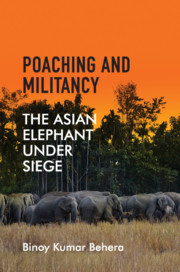2 - Human–Elephant Conflict
Published online by Cambridge University Press: 23 November 2018
Summary
In order to understand the reason behind elephant deaths, it would be desirable to first look at the broader issue of the intensifying human–elephant conflict. Humans and elephants have been coexisting for long, and even while humans have domesticated elephants for their needs, the two have always had separate areas for habitation. For the former, it has been open land suitable for their livelihood, and for the latter, the forests. It is not that the demarcation between the two areas of living was always so rigid that one did not infringe on the other: humans being dependent on and entering forests for many of their needs and animals often straying into areas of human habitation. However, this was more the exception than the rule and not to the extent as would cause much hindrance to either's undisturbed existence in its respective habitat. It is when this balance gets disturbed to the extent of normal habitation becoming difficult that things begin to go awry and the roots of conflict originate.
Human–elephant conflict can be broadly categorised into two kinds—one, what humans do to elephants, and the other, what elephants do to humans. The former primarily consists of humans causing elephant deaths which, being the integral subject of this study, will be examined in a separate chapter. Persecution by humans of elephants foraying into crop fields and households is a reaction to elephant depredations and hence not strictly a separate feature of the conflict. The second aspect of the conflict, which is what elephants do to humans, and what has been agitating people against them, is the raiding of crops and households as also their injuring and killing of humans. As the former trait is examined separately, it is proposed to illustrate what elephants do to humans from a slightly different perspective through two self-explanatory, personally experienced case studies.
Crop Raid
Crop raiding by elephants is both a cause and symptom of conflict. For the large number of farmers whose crops and thereby their livelihood is destroyed, it is the prime cause of conflict. From the elephant's perspective, however, habitat destruction by humans that limits its forage options is actually the root cause of conflict and crop raids by elephants, only its symptom. Whichever way one looks at it, crop raiding by elephants is the most visible and widespread manifestation of human–elephant conflict.
- Type
- Chapter
- Information
- Poaching and MilitancyThe Asian Elephant under Siege, pp. 16 - 47Publisher: Cambridge University PressPrint publication year: 2019



